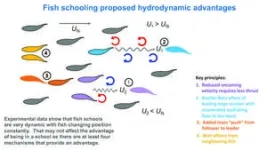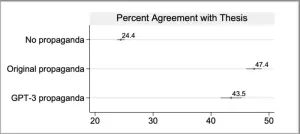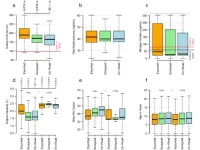(Press-News.org) Many animals, including apex predators, move in groups. We know this collective behavior is fundamental to the animal’s ability to move in complex environments, but less is known about what drives the behavior because many factors underlie its evolution. Scientists wonder, though, if all these animals share a fundamental drive such as for mating, safety, or perhaps even to save energy.
“The keyword is perhaps,” said Yangfan Zhang, postdoctoral researcher in the Department of Organismic and Evolutionary Biology (OEB) at Harvard, “because no one has actually measured this and compared it directly across all animal groups, mainly because it’s difficult to have a system that can measure not just a group, but individuals in that group. But, we do know that, evolutionarily, there is some pressure to optimize for efficiency of energy use.”
In a new study published in eLife, Zhang and co-author Professor George Lauder, also in OEB and Curator of Ichthyology in the Museum of Comparative Zoology, questioned if coordinated group movements by animals moving through a fluid could reduce the energy cost of locomotion. By combining biomechanics and bioenergetics (measuring metabolic energy consumption and animal movement simultaneously in a highly specialized experimental platform) the researchers found not only a significant amount of energy conservation, but also identifed the reduced energy use per tail beat.
Terrestrial vertebrates evolved from fish, transitioning from fins to limbs and modifying respiratory organs from aquatic breathing to air. Despite different environments and breathing systems, all vertebrates and fish share the same metabolic pathways to produce energy. One pathway uses oxygen called aerobic metabolism. The other pathway, called anaerobic, is used when oxygen is limited, or cannot supply sufficient energy to move at the high speeds. Combined, they contribute to the total energy expenditure of movement. Fish, however, have a greater need to optimize their locomotion than for animals moving in the air or on land. This is because water is 50 times more viscous a fluid than air and demands considerable energy to overcome fluid resistance during movement. Water also contains five times less oxygen per kilogram compared to air; meaning aquatic animals are “squeezed” by a lower ceiling of oxygen availability and have a higher pressure on energetic demand.
To test the energy cost of locomotion in fish, Zhang and Lauder designed a sealed water “treadmill” that controlled water velocity. By measuring the rate at which oxygen is removed from the sealed “treadmill”, the researchers were able to distinguish the rate of oxygen uptake by the animals.
“The system is designed to have the measuring sensitivity to capture the energetic cost of an individual fish compared directly to the cost for a group of eight fish,” said Zhang. “By standardizing the biomass of the fish in the water treadmill with controlled water velocity, we can directly compare the cost of swimming between fish schools and an individual fish.”
The “treadmill” also employed two high-speed orthogonal cameras to capture unique locomotion features—one a side view, the other from the bottom. This helped to measure the three-dimensional positions of the fish and allowed the researchers to measure the distance between fish in the school.
“What we discovered is that the total cost for the group to move as a whole is much lower per biomass compared with an individual, and the group expended the least amount of energy at a median speed of one body length per second,” Zhang said. “When we look at studies that track wild animals, we find that a lot of animals migrate at a speed of around one body length per second.”
The researchers found that moving quickly required more energy, but so did moving slowly. However, at a medium speed of one body length per second, they saw a dip in the energetic curve where swimming was at a minimum cost, which increased at both faster and slower speeds presenting a J-shaped relationship.
As the most diverse vertebrate group, fish species have an immense cultural and commercial value to human society. Yet, changing climates are a direct challenge to the biodiversity of fish.
“Projections on the future abundance of fish species cannot be based only on the biology of the individuals,” Lauder said, “we also need a fundamental understanding of collective movement that accounts for the interactions among the individuals within a group. Studying the energetics of aquatic locomotion under environmental constraints offers insight not only into highly conserved features of vertebrate physiology, but also into the inner workings of fluid dynamics principles and animal locomotion.”
“I think the beautiful thing about this study is that we captured the full spectrum of the energy expenditure in a holistic way that enabled us to account for an energy cost moving at high speeds,” said Zhang. “Scientists have been looking at this question for decades, but we found that the key lay in measuring not just the aerobic, but also the anaerobic costs. That is a huge part for any organism and, without measuring both, you get only half the story.
END
Unlocking the energetic secrets of collective animal movement: How group behavior reduces energy costs in fish
2024-02-20
ELSE PRESS RELEASES FROM THIS DATE:
Wide variation in rates of police killings suggests unnecessary deaths
2024-02-20
One in three police homicides could have been avoided without endangering police or the public, according to a study. Eight percent of all homicides of adult men in the United States are committed by police. Using data from 2008–2017 from the National Officer-Involved Homicide Database, Josh Leung-Gagné compared police homicide rates across the 711 local police departments serving 50,000 or more residents in the United States. One explanation for differing rates of police killings is that some jurisdictions are riskier than others, which necessitates ...
High persuasiveness of propaganda written by AI
2024-02-20
Research participants who read propaganda generated by the AI large language model GPT-3 davinci were nearly as persuaded as those who read real propaganda from Iran or Russia, according to a study. Josh Goldstein and colleagues identified six articles, likely originating from Iranian or Russian state-aligned covert propaganda campaigns, according to investigative journalists or researchers. These articles made claims about US foreign relations, such as the false claim that Saudi Arabia committed to help fund the US-Mexico border wall or the false claim that the US fabricated reports showing that the Syrian government had used chemical weapons. For each ...
Junk DNA in birds may hold key to safe, efficient gene therapy
2024-02-20
The recent approval of a CRISPR-Cas9 therapy for sickle cell disease demonstrates that gene editing tools can do a superb job knocking out genes to cure hereditary disease. But it's still not possible to insert whole genes into the human genome to substitute for defective or deleterious genes.
A new technique that employs a retrotransposon from birds to insert genes into the genome holds more promise for gene therapy, since it inserts genes into a "safe harbor" in the human genome where the insertion won't disrupt essential genes or lead to cancer.
Retrotransposons, or retroelements, are pieces of DNA that, when transcribed ...
Fasting-like diet lowers risk factors for disease, reduces biological age in humans
2024-02-20
Cycles of a diet that mimics fasting can reduce signs of immune system aging, as well as insulin resistance and liver fat in humans, resulting in a lower biological age, according to a new USC Leonard Davis School of Gerontology-led study.
The study, which appears in Nature Communications on Feb. 20, adds to the body of evidence supporting the beneficial effects of the fasting-mimicking diet (FMD).
The FMD is a five-day diet high in unsaturated fats and low in overall calories, protein, and carbohydrates and is designed to mimic the effects ...
New model identifies drugs that shouldn’t be taken together
2024-02-20
CAMBRIDGE, MA -- Any drug that is taken orally must pass through the lining of the digestive tract. Transporter proteins found on cells that line the GI tract help with this process, but for many drugs, it’s unknown which of those transporters they use to exit the digestive tract.
Identifying the transporters used by specific drugs could help to improve patient treatment because if two drugs rely on the same transporter, they can interfere with each other and should not be prescribed together.
Researchers at MIT, Brigham and Women’s Hospital, and Duke University ...
Study shows UK offshores emissions through used vehicle exports
2024-02-20
Published today in Nature Climate Change, the study found that exported used vehicles generate at least 13-53% more emissions per mile than those that are scrapped or on the road in Great Britain. The researchers used mandatory annual vehicle inspections – known as MOT tests – of all 65 million used vehicles on British roads between 2005 and 2021 to compare the pollution and emissions intensity of vehicles exported to those scrapped, destroyed, or driven in Great Britain.
The data revealed substantially higher rates of carbon dioxide and pollution generation in exported vehicles. ...
Study: whether you exercise regularly or one-to-two days a week, weight loss is possible
2024-02-20
ROCKVILLE, Md.— Whether you engage in physical activity on a regular basis or one-to-two days a week, both options produce weight loss suggests a new study published in the journal Obesity, The Obesity Society’s (TOS) flagship journal. The study is the first of its kind to examine the association between physical activity patterns and objectively-measured fat tissue mass.
Guidelines from the World Health Organization recommend that adults perform at least 150 minutes per week of moderate physical activity, 75 minutes per week of vigorous physical activity or an equivalent combination of both intensities. ...
Health care inequities behind shorter life spans for Inuit from Nunavik, Quebec, with lung cancer
2024-02-20
People living in the Inuit region of Nunavik in northern Quebec die earlier after a diagnosis of lung cancer than Montreal residents receiving treatment at the same cancer centre, according to new research published in CMAJ (Canadian Medical Association Journal) https://www.cmaj.ca/lookup/doi/10.1503/cmaj.230682.
All inhabitants of Nunavik are investigated and treated for cancer at the McGill University Health Centre (MUHC) in Montreal, more than 1400 km away from Nunavik hospitals, due to limited resources in the region.
Researchers compared lung cancer survival ...
Anorexia nervosa can be life threatening in males
2024-02-20
Anorexia nervosa affects males as well as females, and affected males have a sixfold higher mortality rate than males in the general population. A new article published in CMAJ (Canadian Medical Association Journal) aims to raise awareness of this life-threatening eating disorder. https://www.cmaj.ca/lookup/doi/10.1503/cmaj.230001
"Early identification and prompt treatment are essential," writes Dr. Basil Kadoura, a specialist in adolescent health, British Columbia Children's Hospital and University of British Columbia, Vancouver, BC, with coauthors.
Five things to know about anorexia nervosa in males:
Up to 0.3% of males will be diagnosed with anorexia nervosa. ...
Researchers are using RNA in a new approach to fight HIV
2024-02-20
Society learned about the value of mRNA during the COVID-19 pandemic when we saw scientists and medical professionals harness its power to deliver a vaccine for the virus within a year.
Now, University of Waterloo pharmacy associate professor Emmanuel Ho has developed a novel nanomedicine loaded with genetic material called small interfering RNAs (siRNA) to fight human immunodeficiency virus (HIV) using gene therapy. These siRNAs regulate which genes or proteins are turned on or off in our cells and showed a 73 per cent reduction in HIV replication.
“This opens the door for new therapeutics in the fight against HIV,” ...




